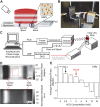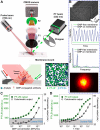Signal amplification and quantification on lateral flow assays by laser excitation of plasmonic nanomaterials
- PMID: 32292500
- PMCID: PMC7150487
- DOI: 10.7150/thno.44298
Signal amplification and quantification on lateral flow assays by laser excitation of plasmonic nanomaterials
Abstract
Lateral flow assay (LFA) has become one of the most widely used point-of-care diagnostic methods due to its simplicity and low cost. While easy to use, LFA suffers from its low sensitivity and poor quantification, which largely limits its applications for early disease diagnosis and requires further testing to eliminate false-negative results. Over the past decade, signal enhancement strategies that took advantage of the laser excitation of plasmonic nanomaterials have pushed down the detection limit and enabled quantification of analytes. Significantly, these methods amplify the signal based on the current LFA design without modification. This review highlights these strategies of signal enhancement for LFA including surface enhanced Raman scattering (SERS), photothermal and photoacoustic methods. Perspectives on the rational design of the reader systems are provided. Future translation of the research toward clinical applications is also discussed.
Keywords: SERS; gold nanoparticles; lateral flow assay; nanoparticle heating; signal amplification and quantification.
© The author(s).
Conflict of interest statement
Competing Interests: ZQ is listed on patents related to thermal contrast amplification and has the equity interest in Vigilant Diagnostics.
Figures






References
-
- Leuvering JH, Thal PJHM, Waart MVD, Schuurs AHWM. Sol particle immunoassay (SPIA) J Immunoassay. 1980;1:77–91. - PubMed
-
- Parolo C, Merkoçi A. Paper-based nanobiosensors for diagnostics. Chem Soc Rev. 2013;42:450–7. - PubMed
-
- Xu Y, Liu Y, Wu Y, Xia X, Liao Y, Li Q. Fluorescent probe-based lateral flow assay for multiplex nucleic acid detection. Anal Chem. 2014;86:5611–4. - PubMed
-
- Urusov AE, Gubaidullina MK, Petrakova AV, Zherdev AV, Dzantiev BB. A new kind of highly sensitive competitive lateral flow immunoassay displaying direct analyte-signal dependence. Application to the determination of the mycotoxin deoxynivalenol. Microchim Acta. 2018;185:29. - PubMed
-
- Zhou Y, Ding L, Wu Y, Huang X, Lai W, Xiong Y. Emerging strategies to develop sensitive AuNP-based ICTS nanosensors. Trends Analyt Chem. 2019;112:147–60.
Publication types
MeSH terms
Grants and funding
LinkOut - more resources
Full Text Sources
Other Literature Sources
Miscellaneous

